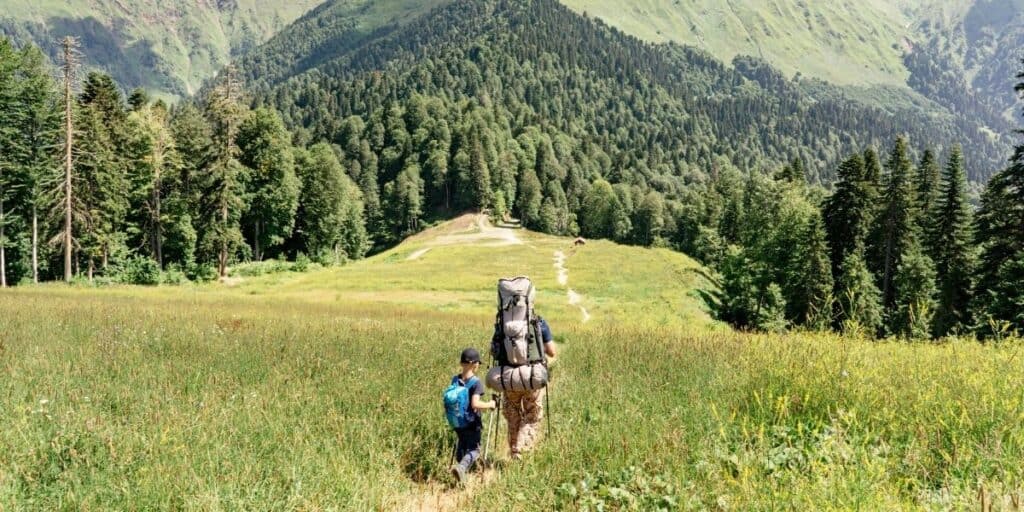I became interested in environmental issues and climate change right after my now 11-year-old son was born. I sat with him in my arms on maternity leave, I watched CNN’s coverage of the Deepwater Oil Spill in the Gulf Coast each evening. I was a brand new mom already full of new-mom anxiety. Becoming more aware of environmental issues like climate change made me worry that my kids would become adults on a planet in distress. I felt a sense of hopelessness for him and my future grandkids (I’m already excited for grandbaby’s… no pressure kids).

Today, I’m in a different place. My son is 11-years-old and my daughter is 8-years-old. We talk about environmental issues all the time, but not in a way that’s scary or shaming. Instead, we talk about the environmental solutions we’re implementing at home, and why.
My kids are actually more educated in environmental solutions than environmental issues, mostly because that’s what we choose to focus on at home. Here I explain how my husband and I talk with our kids about environmental issues, why I encourage you to work through your own climate anxiety before you do and then come up with your own sustainable living plan.
Here’s how to talk with kids about environmental issues without scaring them:
Work through your own climate anxiety first
There’s a lot of anxiety about climate change these days. Part of what brought me to this sustainable living journey was driven by my own climate anxiety, so in many ways, I’m grateful for it. It’s part of my own story and the beginning of my sustainable living journey. So I don’t want to suggest that it’s bad or that you should stop feeling it. Feel your feelings. Feelings are fine. But it may be counterproductive to talk to your children about environmental issues before you’ve worked through your own anxiety. I’m a huge fan of therapy for everyone, everywhere. No matter what you’re struggling with. So start by talking to a competent professional that can help you work through any anxiety you may have about environmental issues productively.
Decide which environmental issue you want to focus on solving
My husband and I have decided that the environmental issue we want to be part of solving is climate change and pollution. We do this by reducing our family’s dependence on fossil fuels. You might focus on reducing waste by using reusable water bottles and coffee cups. Or maybe you want to focus on your diet and eat less red meat and dairy. Every solution is legitimate and fairly easy to take small steps toward implementing.
Develop a sustainable living plan for your family
When you know which environmental issue you want to be part of the solution to, then you can develop a sustainable living plan. This will look different for every family. It may also look different to every individual in the family. But it doesn’t have to be complicated. For example, our plan is to reduce our family’s dependence on fossil fuels. For us, that means we’re replacing gas-powered appliances and cars as they need replacing. It doesn’t have to be complicated. In fact, the simpler the plan, the easier it is to implement.
Talk about your sustainable living plan
When you have a sustainable living plan, it becomes much easier to talk to your kids about environmental issues because instead of focusing just on what’s scary or sad, you can also explain what your family is doing about it. Having a plan helps your kids (and the entire family) feel more empowered. It also makes environmental issues sound less scary when you know there are solutions and you are personally contributing to environmental solutions rather than just the problems.
Enjoy nature with your kids
When my kids were little (before they started elementary school) I almost never talked to them about environmental issues. Instead, we spent a lot of time outside. We often go hiking or take trips to the beach as a family. Even just going to the playground will teach kids about the beauty of nature. Ultimately the most important thing you can teach your kids is that nature is worth protecting.
Talk about environmental issues as they come up
When environmental issues come up, talk about them to the best of your ability. If you’re not sure about something, be honest. Then ask Google. Google doesn’t have all the answers, but it can usually help with the basics. Avoid blaming and shaming people for environmental issues as much as possible. It’s important that kids understand that people can be just as much a part of the solution as the problem. When we keep this in mind, it’s easier to talk about environmental issues in general.
What we tell our kids about environmental issues and solutions
Now that you see how you can talk to kids about environmental issues without scaring them, I’ll explain our family’s sustainable living plan. I’ve written about this in more detail in Our sustainable home improvement plan for going electric. This is how we talk to our kids about it.
We’re phasing out fossil fuels
Slowly but surely, we’re phasing out the fossil fuels that have powered our cars and appliances in the past. Our kids know that we sold the natural gas range because we’re trying to go all-electric at home. We have solar panels and they’ve helped clean them (when they were on the ground, not on the roof.)
They understand we have a natural gas fireplace that we still use, but that we will eventually replace it with an electric one. They were there when we removed our old wood-burning fireplace and replaced it with an electric fireplace.
Side note: We had two wood-burning fireplaces when we bought the house eight years ago. And yes, we turned one of them into a gas fireplace without thinking about the environmental impact at that time. Yes, it was a mistake on our end. At that time I only slightly aware of the health and environmental issues associated with natural gas at home. I learned more about how harmful natural gas when I wrote Home electrification: Why cities are phasing out natural gas.
All this may seem like weird things for kids to know. But for us, it’s a big part of our life. My husband and I are both committed to electrifying everything. It’s the thing we think will have the biggest impact on reducing our family’s carbon footprint. Phasing out our family’s dependence on fossil fuels is not an inexpensive or easy thing to do, but it is the one thing we agree that we can do to improve our family’s lives and our impact on the environment.
Read: Easy healthy home tips
We talk about greenhouse gases
Our 8-year-old daughter loves chemistry so we talk about what greenhouse gases are in an age-appropriate way. With her, we’ve explained that we’re trying to make fewer “bad gases” (greenhouse gases) at home. She understands that climate change is caused by too many “bad gases” trapped in the atmosphere. That’s an overly simplistic way of talking about climate change, but it’s how we help her understand it on a second-grade level. With our 11-year-old son, we use the words greenhouse gases and climate change because he’s learned about it in school and he already has the vocabulary to talk about it.
We focus on progress, not perfection
We also tell our kids that we are not perfectly green, and that’s ok. I don’t strive to be perfect, and I don’t expect my kids to be perfect either. My only goal for my kids is that they understand that their parents care about the environment and that we make conscious decisions to reduce our family’s environmental impact. In other words, we focus on progress not perfection.
When the kids look back at our environmental decisions in 30 years they very well may choose to believe that we could or should have done more to help slow climate change. Or maybe they will remember that we did our best with what we knew at the time. I hope they will trust that we did our best.
Learn more about environmental solutions
With that said, I do have a few books to recommend that may help you along in your journey.
How to Avoid a Climate Disaster: The Solutions We Have and the Breakthroughs We Need by Bill Gates is a must-read if you’re interested in climate change, environmentalism, and human progress.
Drawdown: The Most Comprehensive Plan Ever Proposed to Reverse Global Warming by Paul Hawken was my go-to book on environmental solutions before How to Avoid a Climate Disaster came along. Drawdown has pictures that your kids might like if you buy the hard copy.
Both will leave you feeling much more hopeful about the state of our environment, and what you can do to help it.
